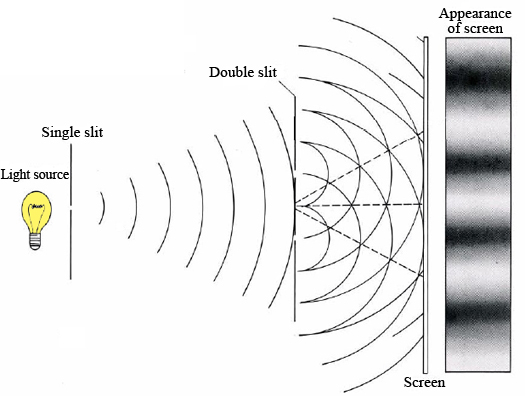The original question was: If I don’t open the lid of the bunker, the cat inside is either dead OR alive. Why does Schrödinger say that the cat is both alive AND dead if I do not perform the act of observation? Isn’t he confusing AND for OR?
Physicist: He’s very intentionally saying “and” and not saying “or”.
When something is in more than one place, or state, or position, we say it’s in a “superposition of states”. The classic example of this is the “double slit experiment”, where we see evidence of a single photon interfering with itself through both slits.

The patterns on the screen cannot be described by particles of light traveling in a straight line from the source. They can be described very easily in terms of waves (which go through both slits), or by saying “particles of light certainly do behave oddly, yessir” (hidden variables).
Schrödinger’s Equation describes particles (and by extension the world) in terms of “quantum wave functions”, and not in terms of “billiard balls”. His simple model described the results of a variety of experiments very accurately, but required particles to behave like waves (like the interference pattern in the double slit) and be in multiple states. In those experiments, when we actually make a measurement (“where does the photon hit the photographic plate?”) the results are best and most simply described by that wave. But while a wave describes how the particles behave and where they’ll be, when we actually measure the particle we always find it to be in one state.
“Schrödinger’s Cat” was a thought experiment that he (Erwin S.) came up with to underscore how weird his own explanation was. The thought experiment is, in a nutshell (or cat box): there’s a cat in a measurement-proof box with a vial of poison, a radioactive atom (another known example of quantum weirdness), and a bizarre caticidal geiger counter. If the counter detects that the radioactive atom has decayed, then it’ll break the vial and kill the cat. T0 figure out the probability of the cat being alive or dead you use Schrödinger’s wave functions to describe the radioactive atom. Unfortunately, these describe the atom, and hence the cat, as being in a superposition of states between the times when the box is set up and when it’s opened (in between subsequent measurements). Atoms can be in a combination of decayed and not decayed, just like the photons in the double slit can go through both slits, and that means that the cat must also be in a superposition of states. This isn’t an experiment that has been done or could reasonably be attempted. At least, not with a cat.
Schrödinger’s Cat wasn’t intended to be an educational tool, so much as a joke with the punchline “so… it works, but that’s way too insane to be right”. At the time it was widely assumed that in the near future an experiment would come along that would over-turn this clearly wonky interpretation of the world and set physics back on track.
But as each new experiment (with stuff smaller than cats, but still pretty big) verified and reinforced the wave interpretation and found more and more examples of quantum superposition, Schrödinger’s Cat stopped being something to be dismissed as laughable, and turned instead into something to be understood and taken seriously (and sometimes dropped nonchalantly into hipster conversations). Rather than ending with “but the cat obviously must be alive OR dead, so this interpretation is messed up somewhere” it more commonly ends with “but experiments support the crazy notion that the cat is both alive AND dead, so… something to think about”.
If it bothers you that the Cat doesn’t observe itself (why is opening the box so important?), then consider Schrödinger’s Graduate Student: unable to bring himself to open one more box full of bad news, Schrödinger leaves his graduate student to do the work for him and to report the results. Up until the moment that the graduate student opens the door to Schrödinger’s Office, Schrödinger would best describe the student as being in a superposition of states. This story was originally an addendum to Schrödinger’s ludicrous cat thing, but is now also told with a little more sobriety.
The double slit picture is from here.







29 Responses to Q: Before you open the box, isn’t Schrödinger’s cat alive or dead, not alive and dead?